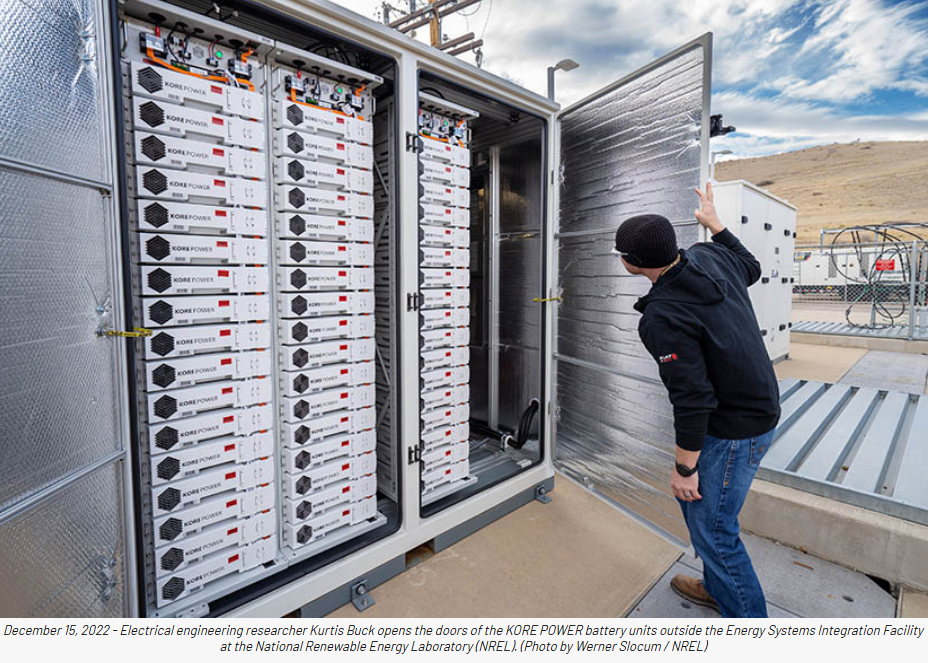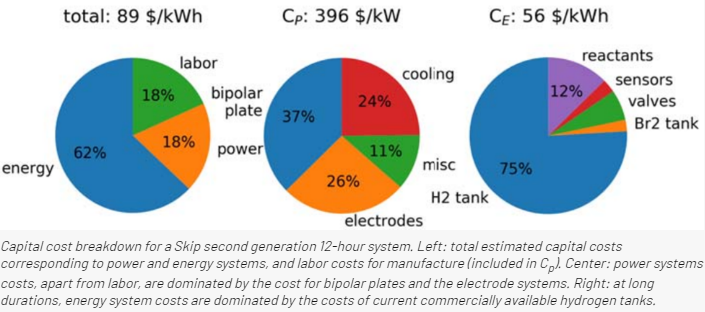Contributed by Dr. Brennan Gantner, CEO and co-founder of Skip Technology
View the original article here

This article is part two of a two-part series addressing energy curtailment. Part one was published earlier this week on Renewable Energy World.
While a thought experiment involving the free construction of infinite wind energy generation capacity elucidates the economics of generation vs. curtailment, it sidesteps the problem of time-shifted generation vs. usage peaks. Wind may blow at any time, in any location, so a sufficiently large number of turbines could conceivably cover peak usage needs with large curtailment off-peak. Solar, however, is locked to overhead sunlight hours, so it cannot be harvested at all desired usage times, at least without very long-distance transmission, which represents a much larger problem. To convert to a renewable energy (RE) world, with large amounts of solar production, energy storage isn’t just an economic problem, it is fundamentally required.
Lithium (li)-ion storage is, currently, the dominant player in grid-scale energy storage, but there is insufficient capacity in current leading li-ion battery technology to supply the grid-scale storage necessary to accommodate even the current levels of RE generation. This supply side failure is a direct driver of curtailment in California and many other markets. Exploration of alternative solutions that offer to offset the resource restrictions that impact li-ion energy storage include pumped hydro (Lake Mead), electro-mechanical (Energy Vault), thermal (Ambri), and alternative electro-chemistries (Form, ESS Inc.), but always at a high economic or land-use cost. Many solutions are simply worse than lithium but are still being investigated due to the overwhelming necessity of storage for a functional RE grid.
Each of the above, including li-ion storage, comes at a higher cost in the current market than the costs resulting from curtailment. Again, this is a direct driver for why energy curtailment happens at large scales: it is simply cheaper, currently, to build more RE generation than it is to store large amounts of energy. As the above technologies reach developmental maturity, however, costs should fall quickly.
How can we better address curtailment in the future?
The next generation of energy storage is almost certainly going to be composed of many different storage solutions. Li-ion continues to come down in costs, and may eventually reach parity with generation costs. Without a huge breakthrough in the technology, however, it still presents many issues related to sourcing, mining, processing, and recycling the rare earth metal(s) involved. Solid-state batteries, just starting to appear on the market, are likely game-changing in many areas.
Moreover, much of the standard battery construction capacity for the foreseeable future is likely to be taken up in the transition from internal combustion vehicles to electric vehicles (EVs), where weight, size, and charge characteristics are incredibly important. These requirements make alternative solutions difficult to implement, as evinced by how long it took for electric vehicles to become commercially viable from initial inception. The first EV was created in 1828 by Hungarian Anyos Jedlik, meaning battery storage technology took almost 200 years to arrive at a commercially viable solution.
A cheaper storage model is clearly needed. Since the requirements for stationary energy storage are more relaxed, one likely option is cost-competitive alternative electro-chemistries. Among many working on this, Skip Tech is developing a high power density, high energy density, liquid system for long-duration energy storage (LDES). In comparison to traditional li-ion batteries, the electrolytic solution is not integrated into the structure of the system, but stored separately and passed through the power cells, where the energy stored in the electrolytic fluids can be extracted or stored by reversing the flow. Flow battery technologies, like the Skip Tech liquid battery, offer many advantages including the ability to customize the duration of storage separately from the amount of power delivered, and in some cases can even support “refueling” approaches, where the fuels used in the system are “charged” at one site and then are transported to the energy storage system, allowing “recharging” without direct grid connection.
A system in which the electrolytic “fuel” is removable can be operated in the more traditional manner of fossil fuel power plants by removing the fuel from the potential RE site and transporting it to an electricity-generating plant elsewhere. This, in turn, allows for the reuse of much of the existing infrastructure around fuel storage, transport, and usage. In particular, the US military has studied power usage and generation in the field and determined that it may be unfeasible to construct long-term, on-site RE generation equipment and facilities. Transitioning this existing high-usage system away from fossil fuels may require a fuel delivery system of much the same nature as existing infrastructure. Transitioning to an electrolytic fuel may be that solution: power can be captured elsewhere, such as wind farms in remote locations, stored in the electrolytic fuel, and transported in the same equipment used to transport fossil fuels today. It can then be extracted at the necessary location by a second set of reversible cells in operation much like a traditional power plant, at a steady power, amperage, voltage, and frequency output to better support existing systems that have come to rely on that stability.
The Skip Tech solutions target the key 10-hour duration market and can scale to higher and lower amounts of energy storage. They do so at a competitive price point (<$100/kWh) and with very long expected system lifetimes (20+ years). This same supply chain is replicable in other parts of the world. Their technological breakthrough, utilizing flowing fluid dynamic membranes rather than classical plastic (e.g. Nafion) membranes, solves the longstanding and key problem that has held back flow batteries from wide adoption. While doing so, it also opens up an electro-chemistry that was incompatible with prior membranes. In particular, Skip Tech can use hydrogen and bromine as the reaction couple, which has an incredibly simple reaction chemistry and very favorable reaction energetics.
The key technological innovation in the Skip Tech system lies in the reaction cell. Traditional flow batteries require a separator membrane to allow electron transport but prevent bulk material migration. Skip Tech has developed cells where traditional plastic membranes have been replaced by flowing liquid membranes formed from hydrobromic acid; the resulting system is a “liquid battery.” Liquid batteries hold the promise of greatly reduced costs and longer lifetimes, while also enabling the use of highly reactive chemicals that are not compatible with traditional membranes. Skip Tech is developing these systems into compact, LDES solutions, using hydrogen and bromine as the primary reactive elements. The hydrogen bromine (HBr) reaction has fast kinetics, leading to high power, typically a few kW/m2. It is also easily reversible, leading to high round trip efficiencies, typically >80% DC-DC. Bromine is readily stored in solution within hydrobromic acid, which leads to high energy densities. The hydrogen and bromine are stored in separate tanks, effectively eliminating self-discharge, and this energy storage solution is scalable to meet Department of Energy (DOE) long duration storage shot cost targets. HBr batteries can also operate at a wide range of environmental conditions, specifically in places where heat or cold require temperature regulation for li-ion batteries.

Based on conservative cost modeling, Skip Tech expects to achieve storage costs below $50/kWh in the long run, and levelized costs of storage below $0.05/kWh-cycle, where storage becomes cheaper than extra RE generation capacity. At their current design point, the capital cost of the power system, including labor, is CP =$396/kW ($33/kWh), while the capital cost of the energy system is CE =$56/kWh. These costs decrease further for longer duration systems (e.g., 24 hours of storage costs less per kWh than 12 hours).
Curtailment presents real economic costs that are measurable and additional ethical problems related to waste that are more difficult to quantify. Everyone can agree, however, it is better to produce in proportion to what we need, so long as the costs to do so are advantageous. To that end, we can decrease curtailment with investment in and exploration of new storage technologies to better match electricity generation with usage. This will bring the costs associated with storage down sufficiently so that it becomes more economically viable to store excess energy generation instead of simply wasting it freeing up resources we can devote to more and better pursuits and decreasing human impact on the climate. Thus, investment in storage technologies is a win for everyone.
